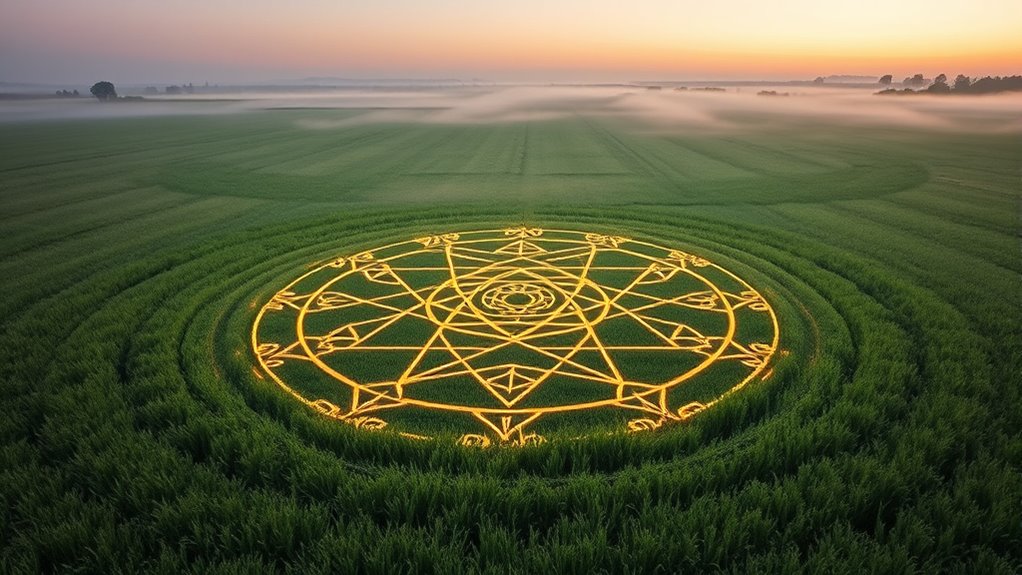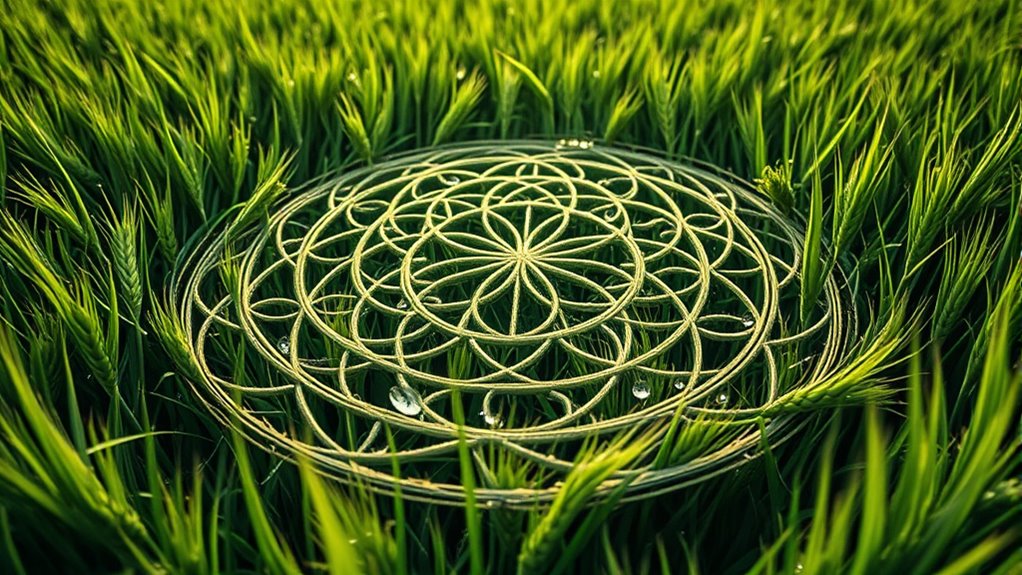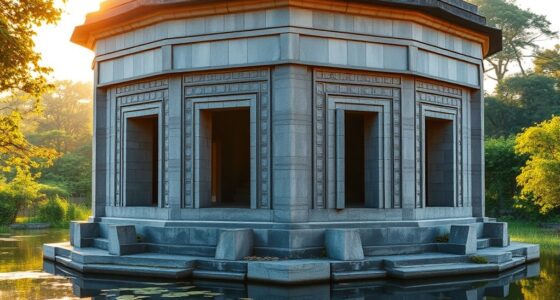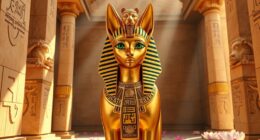Sacred geometry appears in many crop circle designs, merging ancient symbols with modern creations. While some believe these intricate patterns are messages from extraterrestrials, evidence largely points to human craftsmanship using simple tools and planning. Skeptics see them as elaborate hoaxes, but others view them as sacred symbols reflecting cosmic harmony. To understand the true origins—myth or reality—you’ll discover how these patterns relate to ancient wisdom and human artistry.
Key Takeaways
- Many crop circles mimic ancient sacred geometrical symbols, but most are human-made rather than extraterrestrial messages.
- Skeptics attribute crop circles to human artists using simple tools, while believers see them as spiritual or cosmic symbols.
- The intricate geometric patterns in crop circles reflect age-old symbols like Flower of Life, linking modern designs to ancient sacred knowledge.
- Myth suggests crop circles are divine or alien messages, but evidence shows many formations result from deliberate human craftsmanship.
- The debate hinges on interpreting these patterns: as mystical universal codes or as sophisticated human artistic expressions.

Sacred geometry, the study of fundamental patterns and shapes that underpin the universe, often appears in crop circles—mysterious formations that emerge overnight in fields around the world. These intricate patterns seem to echo ancient symbols, linking humanity’s past understanding of the cosmos to contemporary interpretations. When you observe crop circles, you might notice designs resembling the Flower of Life, the Vesica Piscis, or other geometric motifs that ancient civilizations held sacred. These symbols have been found etched into temples, manuscripts, and artifacts from cultures like Egypt, India, and Greece, which viewed them as keys to understanding divine order. Today, many see crop circles as modern manifestations of these age-old symbols, suggesting a continuity of spiritual and mathematical knowledge across millennia. Additionally, the materials and tools used to create some crop circles sometimes incorporate tableware such as stakes and ropes, highlighting the human craftsmanship behind many of these designs.
Yet, it’s important to discern between myth and reality in this sphere. Some believe these geometric patterns are messages from extraterrestrial beings or higher consciousness, encoded in a language that transcends human understanding. Others argue that these formations are the work of skilled human artists using simple tools and meticulous planning. Modern interpretations often lean toward the artistic and cultural significance of crop circles, viewing them as a form of contemporary sacred expression. They mirror the ancient symbols’ emphasis on harmony, proportion, and interconnectedness, reinforcing the idea that these patterns are universal and timeless.
You might wonder why such complex shapes appear so suddenly and mysteriously. Skeptics point out that the majority of crop circles can be traced back to human creators, who employ geometry, measuring devices, and careful planning to produce convincing illusions. These creators often draw inspiration from ancient symbols, reinterpreting them through modern methods to evoke the same sense of awe and spirituality. On the other hand, believers see these formations as a form of sacred communication—messages from higher realms encoded in geometric language that connects the cosmos, consciousness, and the natural world.
In either case, the presence of ancient symbols in crop circles underscores a universal human fascination with understanding the universe’s hidden order. Whether viewed as authentic extraterrestrial messages, spiritual symbols, or human artistic endeavors, these geometric patterns continue to inspire curiosity. They serve as a bridge linking ancient wisdom to modern consciousness, inviting you to explore the profound connections between sacred geometry, symbolism, and cosmic harmony. Ultimately, whether myth or reality, crop circles remind us that the universe’s fundamental patterns remain a source of wonder and discovery.
Frequently Asked Questions
Are Crop Circles Scientifically Proven to Be Alien Messages?
No, crop circles are not scientifically proven to be extraterrestrial communication. Many are man-made, created using simple tools, and feature intricate geometric symbolism that mimics sacred geometry. While some believe these formations could be messages from aliens, there’s no concrete evidence to support that claim. Instead, they often serve as artistic expressions or social experiments, making it clear that crop circles aren’t confirmed as alien messages.
How Do Sacred Geometry Patterns Appear in Ancient Artifacts?
Like whispers from the past, sacred geometry patterns appear in ancient artifacts through deliberate design. You’ll notice these symbols in artifacts’ carvings, mosaics, and structures, reflecting deep-rooted ancient symbolism. By analyzing these artifacts, you can uncover geometric ratios and patterns that reveal universal truths. This connection shows how ancient cultures used sacred geometry to embody spiritual beliefs, linking their craftsmanship to a broader cosmic understanding.
What Tools Do Crop Circle Creators Use?
You’ll find that crop circle creators primarily use simple tools like planks, ropes, and markers to craft their intricate designs. They rely on creation techniques such as measuring, marking, and careful footwork to guarantee precision. These crop circle tools allow for accurate, large-scale patterns, often completed overnight. The process involves methodical planning and skill, making it impressive how such complex geometries emerge through straightforward tools and techniques.
Can Sacred Geometry Influence Modern Architecture?
Yes, sacred geometry influences modern architecture by shaping architectural symbolism and emphasizing geometric harmony. You’ll notice architects incorporate sacred proportions and geometric patterns to create visually appealing, balanced structures. These principles help evoke a sense of harmony and spiritual connection, making buildings more meaningful. By understanding sacred geometry, architects craft spaces that resonate deeply, blending aesthetics with symbolism, and enhancing the overall experience of the environment.
Are There Undiscovered Crop Circles With Hidden Meanings?
Like whispers from the wind, undiscovered crop circles could hide secrets waiting to be unraveled. You might stumble upon new formations that deepen the mystery of origins, revealing intricate patterns woven with purpose. Cultural interpretations vary, casting these circles as messages from ancient civilizations or cosmic signals. As you explore, you’ll find each new discovery adds a layer to the ongoing puzzle, fueling curiosity about what lies beneath the surface of these enigmatic designs.
Conclusion
As you explore sacred geometry and crop circles, remember that the truth often lies somewhere between myth and reality. While some see these patterns as divine messages, others view them as clever hoaxes. Like a puzzle waiting to be solved, they invite curiosity and wonder. Whether you believe in their mystical origins or see them as human art, one thing’s certain: they challenge you to look deeper and appreciate the mysteries that surround us.











